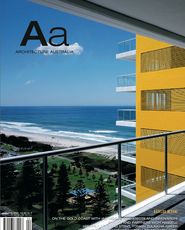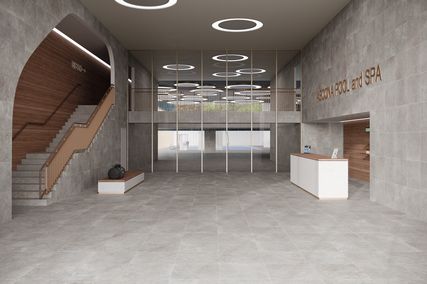This year’s RAIA conference asked speakers to speculate on architecture’s futures. Three delegates – Paolo Tombesi, Laura Harding and Eli Giannini – respond to the event, the speakers and the ideas raised.
FUTURE PAST PAOLO TOMBESI

Elke Delugan Meissl.
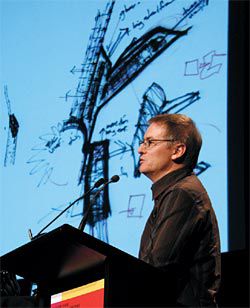
John Wardle.
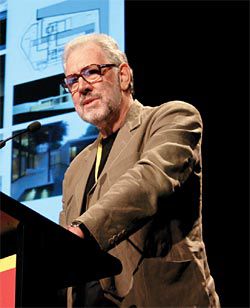
Kerry Hill.
In Behind the Post-Modern Facade (1993), Magali Sarfatti Larson notes that professions such as architecture, characterized by the pervasiveness of a common cultural discourse, find social cohesion through difference.
For Sarfatti Larson, the majority of practitioners – tied to the constraining pragmatics of standard commissions and budgets – derive professional legitimacy from the presence of a smaller group of architectural artists who, through their charisma and out-of-the-ordinary building opportunities, serve as “ideological warrant for the normal or routine practice of the profession as a whole”. Sarfatti Larson’s description suffers perhaps from overcommitment to sociological narratives. Yet, time and again, her theory gets tested and confirmed at annual architectural institutes’ conferences worldwide. In these events members of the profession with portfolios of work exuding intellectual autonomy and operative leeway – and generally implying some form of institutional or individual patronage – are brought in to inspire conference attendees and to galvanize the architectural body into action.
The Future is Now provided yet another example of this peculiar form of reversed pilgrimage by inviting ten diverse practitioners onto its main stage, to provide cues about the future by using their work both as a sphere of self-reflection and as a crystal ball.
The prospect of drawing successful, and in most cases interesting, individual designers into the limelight is of course a tempting one. Recent RAIA conferences have done this very successfully, teasing out powerful testimonies of what it means to be a particular type of architect in the process.
However, problems may arise the moment we ascribe – at least rhetorically, as was the case in Sydney – redemptive, didactic or political value to the work of such champions. When this happens, the natural limitations of Sarfatti Larson’s cultural theory of professional bonding become self-evident: it is one thing to perceive elective affinities with fellow architects, it is another to be able to act upon these affinities within one’s own professional domain.
On such grounds, I found the Sydney convention slightly tokenistic and tactically flawed in that – commendable objectives and fascinating presentations notwithstanding – it left the distance between the rarefied world of design authorship and the crowded universe of honoured vocational trade unspoken.
As Stephen Varady wrote in his introduction, “architects are always thinking about the future”. This should not come as a surprise, given that “to project” means literally “to throw (ideas) forward”. Yet whether or not architects are asked to think actively about the future rather than work, as it were, in the future depends on the context surrounding their work and the demand from which it originates.
This is why the absence of average professional markets from most of the discussion (at least as a point of perspective) was conspicuous. With the exception of a couple of presentations, the landscape of practice “projected” at Darling Harbour (of all places) was either one devoid of constraints or one so full of structural limitations as to require an almost perverse form of collective indulgence for its realization.
Without taking anything away from the work itself, how do Rural Studio’s yearning carpet shacks or Kerry Hill’s exquisite walls, screens and pools exactly engage the future? What do Kerstin Thompson’s residences in Victoria say about changing patterns of inhabitation? Can we all swim into the coves of Baja California that Carme Pinós colonized with her exploded hotel tubes? Or should we rather become part of the photogenic crowd (or Orwellian hordes, you decide) of Coop Himmelb(l)au’s building openings? Even if we resolved to repudiate the instant Hollywood culture promoted by the star of the Sydney show Wolf Prix, could we all seek refuge in Anupama Kundoo’s utopian Auroville, joining the sizeable group of middle-class Western escapees already inhabiting the place?
The obvious answer to all these questions is that the work presented was emblematic of “methods” rather than projects to copy. Objection well taken. But if we were really interested in the future, once methods emerge, shouldn’t we measure their distance from average praxis, trying to understand what is required for the gap to close? In Sydney this would have been made even easier by the fact that some presentations contained material already familiar to the audience, when not recycled outright from previous occasions.
Instead, the opportunity to exploit the experiences selected as tools for reflective discussion was not taken up. The result was that despite the speakers’ best (and sometimes desperate) efforts at sewing the threads of the conference back into their buildings, the presentations remained reflections of themselves.
In my view, this ultimately produced the unthinkable separation of the profession in the auditorium, up on stage and down in the seating area – a separation rendered more overt by the decision to assign architectural theory bards the task of replacing the public’s voice in the presenters’ panel sessions at the end of each day. This was not a felicitous decision. It alienated the audience and meant that the fecund interaction so successfully achieved in Melbourne last year did not take place in Sydney. It also exposed the chasm that can sometimes exist between the academic version of architectural theory and the issues that populate the street theory of architectural practice. Faced with the Sisyphean challenge of pursuing nonexistent lines of discussion (or else feeding the platitudes of Austrian prima donnas), neither Naomi Stead nor Andrew Burges could get themselves out of a suicidal script quickly enough. The future may have looked exciting but the present proved tedious while the rest of the discussion, as Anupama Kundoo intimated, concerned history.
Indeed, it was the interaction between Kundoo and Andrew Freear, Mockbee’s successor at the helm of Rural Studio, that triggered moments of genuine hilarity as well as arresting lucidity. In particular when Freear recommended the audience not to get too hung up on his students’ work, for their whimsical structures are made possible by sheer necessity and consequent make-do philosophy, accompanied by free labour, sweat equity, disrespect of building codes and donated or discarded materials: a formidable pedagogical opportunity but hardly the future we want to work towards.
In the end, the true amalgam of Sydney 2006 for me was Timothy Hill – next year’s creative director-elect and consummate socialite – who went closest to providing some sort of ecumenical closure. He kept his well-rehearsed, sophisticated architectural comedy act clear of self-congratulatory moments but full of illuminating observations about Donovan Hill’s practice, jovial self-condemnation about their work and insightful reflections about the current state of the discipline.
In a way, Hill’s almost protestant insistence on the mechanisms of the present rather than the rhetorics of the future could set up an interesting methodological dialogue between this year’s and next year’s conferences: does the future of architectural practice rest with the elevation of discrete projects to unintentional prototypes (and their authors to occasional heroes) or does it instead rely on informed discussion about collective constraints? I tend towards a blend of the two, looking forward to a time, clearly in the future, when a legislator, a policy-maker and a building developer will share the stage with an incisive architectural discussant publicly to lay out differences, confess fears and declare ambitions. One never knows, it could be Melbourne next year.
›› PAOLO TOMBESI IS ASSOCIATE PROFESSOR OF ARCHITECTURE AT THE UNIVERSITY OF MELBOURNE.
FREEDOM AMID CONSTRAINT LAURA HARDING
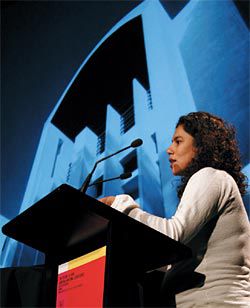
Anupama Kundoo.
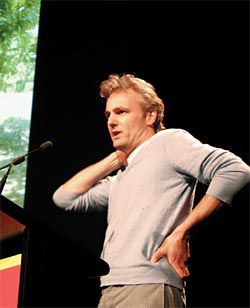
Andrew Freear.
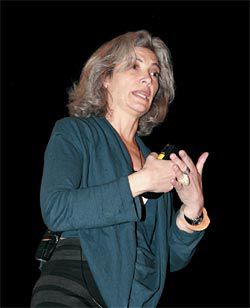
Carme Pinós.
It is ironic that, in an era when social and technological advancement have made the potential of architecture seemingly limitless, constraint and limitation have become a preoccupation. At the recent RAIA National Conference, The Future is Now, reflections on the difficulty of practice were as pervasive as those addressing the architecture itself. How do practitioners find freedom for architecture amidst the current culture of constraint?
Timothy Hill emphasized the difficulty of the task in an alternately excoriating and hilarious account of the tedious, risky and often venomous world of contemporary practice. Scarcely mentioning Donovan Hill’s architectural works, he chose instead to project them as an almost incidental pictorial background, neatly parodying the relevance of architecture to the planners, financiers and bureaucrats who relentlessly stalk its production. Hill urged practitioners to look beyond architecture to secure its future, calling for urgent changes to the education of the planning profession to encompass design and for architects themselves to assume the characteristics of Isaiah Berlin’s famed fox, adopting agility and cunning to evade the deadening influence of the “PLTs” (people like them). His bravura performance suggested that Hill has equipped himself with a more formidable, hybrid armour – wielding the fox’s nimble intelligence as well as the hedgehog’s ability to bristle fearsomely when required.
Kerstin Thompson spoke astutely of her practice’s search for “robust” architecture as a way of negotiating constraint. Not robust in a material or tectonic sense, but in a more calculating and fundamental way, where the generating ideas of the work are interrogated for their potential to not only survive, but thrive in highly contested project processes. Thompson called for the architecture itself to be fox-like – prescient, forearmed and responsive. Insightfully, she also raised the possibility of architecture accepting new limits as a way of reclaiming its rapidly diminishing territory in the mass housing market, asking whether architecture might content itself with broader issues of subdivision, built envelope and the civic realm and forgo the more traditional role of dwelling design to ensure that architects can continue to engage with this economically challenging sector.
Anupama Kundoo and Andrew Freear’s Rural Studio have each found an enviable and unexpected liberty by eschewing the commercial sector and confronting extreme financial constraint in the provision of low-cost housing and civic projects in impoverished rural communities. Constraint has powerfully shaped this architecture’s tectonic and temperament. Modestly conceived and tightly focused, it is buoyed by a strong sense of experimentation, optimism and opportunism that has produced projects with a gritty textural quality and material richness, refreshingly free of the conservatism that accompanies architecture-asspeculation. Kundoo’s inverted terracotta cooking pots and self-fired adobe brick buildings playfully explore the more sustainable use of building materials in India, while Rural Studio’s students have worked with Chevrolet windshields, fishing nets, cardboard bales and even carpet tiles to produce numerous residential projects and the first civic buildings in over 100 years for the citizens of Newbern in rural America.
John Wardle is confronting the speculative and commercial after having first built a practice and profile on the strength of a range of finely crafted residential works. Wardle astutely nurtures the client as the custodian and protector of his architecture, placing them at the centre of the architectural process by abstracting their aspirations into the metaphors and allegories that shape the work. Petri dishes, scarf joints, transparent learning models, grafted vine cultivars, cross-fertilization and the “sampling” of site-specific architectural references have lent the work a simultaneous intellectual richness and broad legibility. Despite a lingering determinism in some of the smaller residential works, the highly accomplished institutional projects display a growing mastery of metaphor – where tensions between metaphor and the more incidental elements of site, programme and scale powerfully catalyse the work.
Wolf Prix and Coop Himmelb(l)au also pursue metaphor, using “sky buildings” and “steel clouds” as the vehicles with which to further their theoretical and formal exploration of architecture. Coop Himmelb(l)au defend their architectural territory and evade the deleterious interference of their corporate benefactors by selling spectacle. They construct evocative physical and digital models, fly in the Disney team to shoot the movie, strap the viewer into a high-velocity helicopter or speedboat, add flashbulbs, fireworks and film stars and amplify the Rolling Stones soundtrack – diverting their clients from the architecture to maximize its chances of escaping with its energy and integrity intact. It was regrettable that Prix also opted for this as the way to position his architecture at the conference. Little of the substance of the work was revealed. We too were sold the spectacle of the steel cloud, improbably supported on spiralling whorls of structure that facilitate ever-increasing cantilevers, and were left to ponder silently the broader contextual issues arising from the acres of “ordinariness” required to support this particular brand of urban exhibitionism.
The contrast with the presentation by the equally charismatic and effusive Carme Pinós was pointed. Pinós presented a range of exquisite architectural and urban projects in a manner designed to be as revelatory as her English would allow. She elucidated a compelling architectural strategy of self-imposed constraint – tightly defining and focusing each project’s “rules” or limits that, once determined, liberate the project to indulge in unimpeded formal exploration. Beautiful, tessellated photographic compositions of the Cube Tower in Guadalajara, Mexico, carefully illustrated its extraordinary experiential and formal qualities, all generated from the simple premise of producing a singular building that could embrace the benign Mexican climate, avoid the need for airconditioning and allow every worker a view outside the building – no soundtrack required.
Will there be freedom for architecture in the future? These practitioners reassure us that there will – if we act shrewdly. Widen our scope to confront the external impediments that tyrannize our discipline, value and interrogate the self-imposed limits and frames that are the basis of our creative freedoms, and dodge, duck and weave to evade the rest in whichever way we can. As Pinós would say in her inimitable way, “it is easy – no?”
›› LAURA HARDING WORKS WITH SYDNEY-BASED PRACTICE HILL THALIS ARCHITECTURE + URBAN PROJECTS.
TALKING ARCHITECTURE ELI GIANNINI
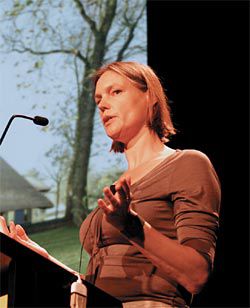
Evelien van Veen.

Timothy Hill.
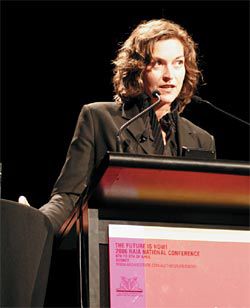
Kerstin Thompson.
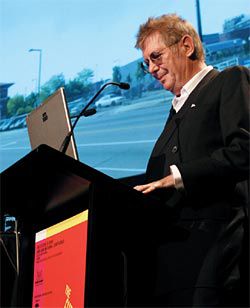
Wolf Prix.
The “new look” RAIA National Conferences under the stewardship of creative directors, Kerstin Thompson last year and Steven Varady this year, have garnered unanimous applause. This success is significant for the Institute – as these events multiplied to become annual fixtures, they had to become a “must” for Australian architects.
As the directors of other events such as the International Series and the biennial student conferences have found, a timely, personal approach from a colleague with an articulate vision can persuade even the most jaded international and home-grown speakers to turn their attention to the “theme” put forward by a fellow creative mind.
Next year will be another first, as Timothy Hill takes the conference outside the Melbourne/Sydney axis (not in terms of location, but in terms of cultural subtext). If his wise and witty performances on stage at the last two conferences are an indication of what is in store, we can all look forward to 2007.
It was with these positives in mind that I agreed to Justine Clark’s request for an opinion piece on this year’s conference.
I came to the conference late on Friday morning to catch most of John Wardle’s presentation. John is a seasoned performer with an anecdotal style that includes many jokes at his own expense. His amusing performances reveal much about his own brand of client-architect relationship, as well as his approach to design.
For example, in his conference presentation he described his remarkable success in winning the substantial commission for a 44-storey residential tower with an illustration he’d used at the interview for the job – all his completed single- and two-storey residential projects stacked on top of each other, forming a more-or-less 44-storey tower. But interspersed with the storytelling John was also trying to explain his design thinking and the things that shape his work. It’s difficult for an architect to do this – it is tempting to find an amusing episode, or to take the debate to “safe” commonly understood concepts.
John also discussed a vineyard house in terms of cuttings from the vine that “inspired” the bifurcated plan. If only it were that simple. The design may well have started with a doodle resembling the particular shape of a vine cutting, but I would have liked to gain a better understanding of the provenance of these exquisitely drawn diagrams, the stylistic influences over the work and his “method” of revealing the sectional cut at the facades of the buildings. It is rare, however, for an architect to be able to critique their own work. It is often others who can reveal what they see in what we do and, in the process, help us to define our own predilections and style, and make conscious what is often a process that started many years ago through intuition and trial and error.
Next Kerry Hill spoke about the influence of Asian vernacular architecture on his own work, but the relevance of the tradition became difficult to believe as his exquisite modernist pavilions changed location from Singapore to Western Australia, Croatia, Queensland, India and Kyoto. It would have been interesting to hear some reflection about the branding of a certain type of image, while remaining true to the local. Or about ways to conduct an international practice in regions where the local architectural traditions are disappearing or diminishing. Or how modernist architecture has established precedents through its association with traditional Japanese architecture.
In Anupama Kundoo’s presentation we were reminded that to practise architecture among some of the world’s poorest is a political act. Her work delighted and shocked with its mix of age-old wisdom, primitiveness and experimentalism. Anupama’s particular interest in adapting traditional craft to contemporary spaces engages sensibilities that we are slowly forgetting here. The construction methodologies we employ remove the labour component from our projects and exalt the material/technological. Likewise, the emphasis we place on computer-generated design methods is in sharp contrast to her labour-intensive projects and the immediacy of her design-as-you-build methods. And, as Andrew Freear commented, there was not a single “sexy Columbia-type graphic” to be seen.
Andrew Freear then took us through the built work of Rural Studio’s architecture school programme. His teaching methods and those of Samuel Mockbee, the studio’s founder and leading light, reminded us of the dilemmas facing architects designing in subsistence conditions: “Do the clients really want these ‘experimental’ works or would they really prefer to look like everyone else?” But Andrew revealed an optimism and courage that stems from the idealism and the ambition of the programme and the enthusiasm of its young practitioners. The chapel made of Chevrolet windscreens and the baseball field and pavilions/nets remind us that architecture is essentially a backdrop for community interaction – an aspect too often overlooked in our corporate commissions.
I concluded my attendance at the conference with the presentation by Carme Pinós. Her work is polished but the presentation left me disappointed. Here again the explanation for the design was dumbed down. We learnt about the topographic and geometric sensibilities in her project for a hotel at Porto Villarta but we didn’t hear about the precedents for coastal projects (Bofill’s Xanadu or Red Wall). Pinós refers us instead to the usual despoiling of the coast by greed and mass tourism that has become commonplace in southern Spain. By contrast, her infill project for an office building within the historic centre of Barcelona shows how rich the work can be when challenged by context and more complex constraints.
These last two conferences have sought to bring us out of our comfort zone and to show us other realities. They have done this well and have proved their true value to the profession. However, what I find less comforting is the reluctance of many speakers to talk about the traditions of architecture and the innovations of our day, the influence that other architects’ work exercises over their own and the relationship that technological, social and philosophical ideas have to the work – while staying within the discipline of architecture.
We shouldn’t need reminders that, as architects, we are the ones qualified to speak about this.
›› ELI GIANNINI IS A DIRECTOR OF MCGAURAN GIANNINI SOON. SHE WILL CHAIR THE 2007 RAIA NATIONAL CONFERENCE TASKFORCE.

